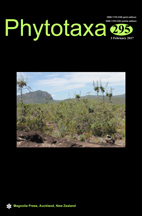Abstract
Most of the species studied in this paper have previously been placed in either Pleurothallis or Lepanthes. However, at one time or another, members of the group have also been placed in the genera Andinia, Brachycladium, Lueranthos, Masdevalliantha, Neooreophilus, Oreophilus, Penducella, Salpistele and Xenosia. Phylogenetic analyses of nuclear ITS and plastid matK sequences indicate that these species form a strongly supported clade that is only distantly related to Lepanthes and is distinct from Pleurothallis and Salpistele. Since this clade includes the type species of Andinia, A. dielsii, and it has taxonomic precedence over all other generic names belonging to this group, Andinia is re-circumscribed and expanded to include 72 species segregated into five subgenera: Aenigma, Andinia, Brachycladium, Masdevalliantha and Minuscula. The required taxonomic transfers are made herein. We hypothesize that convergent evolution towards a similar pollinator syndrome involving deceit pollination via pseudocopulation by Diptera resulted in a similar floral morphology between species of subgenus Brachycladium and species of Lepanthes; hence the prior placement of the species of subgenus Brachycladium in Lepanthes. Species of the re-circumscribed Andinia are confined exclusively to the Andes, ranging from about 1,200 to 3,800 m, from Colombia south to Bolivia, making the generic name very apt. Elevational distributions of the individual clades are discussed in relation to the possible evolutionary diversification of the most species-rich clade, subgenus Brachycladium.

